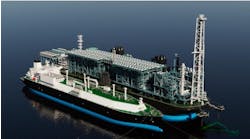NKT Flexibles has qualified its first deepwater flexible riser and is well advanced with qualification of a second.
The work is being done under its Deep Water Development Program (DWD2000), which aims to produce a suite of risers to meet a variety of conditions and oil company requirements. The program has stimulated widespread interest, according to CEO Michael C Hjorth.
The first riser to be qualified is a 6-in. production riser, PR-06, for use in waters to 2,000 m (6,561 ft). The qualification program included an in-plane fatigue test, simulating a free-hanging catenary at 2,000 m (6,561 ft), which was performed with 345 bar operating pressure and dynamic tension varying in phase with the bending.
NKT 6-in. flexible production riser undergoing a tensile test as part of its qualification for use in water depths to 2,000 m (6,561 ft).
A tensile test combined with representative installation crushing loads was also performed. A comparison of the ultimate tensile strength with the predicted value showed little difference, confirming the robustness and accuracy of NKT’s design methodology, says Hjorth.
NKT is currently performing full-scale in-plane fatigue testing of an 8-in. (203 mm) production riser designed for depths down to 1,750 m (5,741 ft). The prototype has been designed with high-temperature capability using NKT’s proprietary single-layer unplasticized polyvinylidene fluoride (PVDF) inner liner.
NKT’s deepwater risers are also intended for high-pressure service. The operating pressure of 345 bar used in testing is equivalent to 5,000 psi, well above the 3,000 psi standard.
“One of the points about our program is the focus we have on different regions,” says Hjorth. “We aim to meet the different requirements of different oil companies in the major deepwater provinces, Brazil, West Africa, Gulf of Mexico, Far East Asia, and so on.”
NKT is also carrying out extensive R&D to enhance the performance characteristics of polymeric and metallic materials. In a second phase of the program, it plans to make further use of its expertise in exotic and high-performance materials, such as XLPE, cross-linked polyethylene does not degrade when exposed to water over time.
“This is another respect in which we differ from our competitors, by using not only standard materials, but also more exotic materials in order to achieve a broader performance range,” Hjorth says.




